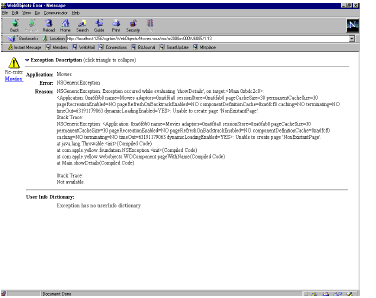Understanding the Default WebObjects Error Page
Synopsis
Describes the structure and layout of the default WebObjects error page.
Description
By default, when an error occurs in your application, WebObjects returns a page containing debugging information. This page is displayed in the Web browser and contains information that may be useful in the debugging of your application.

The default error page consists of the Exception Description and a hyperlink that restarts the application. The Exception Description contains information that may be useful in debugging the error. It is broken into the following areas:
|
Application
|
The name of the application with the error.
|
|
Error
|
This defines the name of the exception that occurred. The exception names are defined in NSException.h. Common exceptions include NSGenericException, NSRangeException, and NSInvalidArgumentException.
|
|
Description
|
The description provides detailed information concerning the error. This information contains the name of the method that was executing when the error occurred, the contents of the Application Object, a human-readable short description of the cause of the error, and a stack trace at the point at which the error occurred.
|
|
User Info Dictionary
|
This dictionary is used to supply data to the exception handler. For example, an application may raise an exception if the return value of a method is out of range, and store the return value in the User Info Dictionary for the exception handler to display. Not all code that raises exceptions provides a User Info Dictionary.
|
The default error page is defined at
$NEXT_ROOT\Library\Frameworks\ WOExtensions.framework\ Resources\WOExceptionPage.wo.
Questions
-
How do I use information from the error page to debug my application?
Keywords
-
Error Page
-
Error Handling
-
Exception Handling
Revision History
22 July, 1998. John Malach. First Draft.
26 October, 1998. Clif Liu. Second Draft.
© 1999 Apple Computer, Inc.

 [an error occurred while processing this directive]
[an error occurred while processing this directive]



